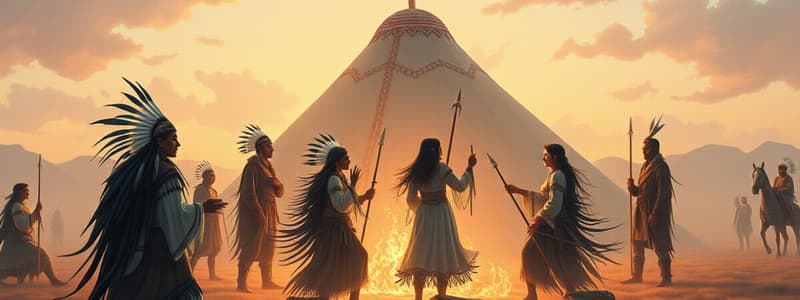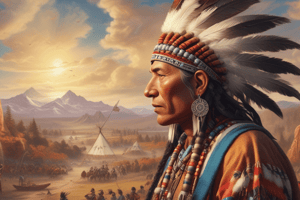Podcast
Questions and Answers
What was the Ghost Dance religion believed to cause?
What was the Ghost Dance religion believed to cause?
- The disappearance of white men (correct)
- The rise of industrialization
- The creation of new laws
- The restoration of lands to Native Americans (correct)
What event led to the Wounded Knee Massacre?
What event led to the Wounded Knee Massacre?
The U.S. government's attempt to stop the Ghost Dance religion among the Sioux.
What did the Dawes Severalty Act aim to promote?
What did the Dawes Severalty Act aim to promote?
Individual land ownership among Native Americans.
What did the Gold Rush of 1849 initiate?
What did the Gold Rush of 1849 initiate?
What was the Overland Trail?
What was the Overland Trail?
What was granted under the Homestead Act of 1862?
What was granted under the Homestead Act of 1862?
What was the purpose of the National Reclamation Act?
What was the purpose of the National Reclamation Act?
Define placer mining.
Define placer mining.
What was the Comstock Lode known for?
What was the Comstock Lode known for?
What did the Chinese Exclusion Act of 1882 achieve?
What did the Chinese Exclusion Act of 1882 achieve?
What were Exodusters?
What were Exodusters?
What is dry farming?
What is dry farming?
What are bonanza farms?
What are bonanza farms?
What was the National Grange of the Patrons of Husbandry?
What was the National Grange of the Patrons of Husbandry?
What is Turner's Thesis about?
What is Turner's Thesis about?
Flashcards are hidden until you start studying
Study Notes
Ghost Dances
- A late 19th-century religious movement led by Wavoka, a Paiute Indian.
- Followers believed it would make white men disappear and restore Native American lands.
- The U.S. government outlawed the movement, leading to the Wounded Knee Massacre.
Wounded Knee Massacre
- Occurred in December 1890 involving Sioux led by Chief Big Foot.
- Troopers aimed to suppress the Ghost Dance religion.
- An uncertain initial shot triggered violence, resulting in approximately 200 Native American deaths.
Dawes Severalty Act
- Passed by Congress in 1887 to promote individual land ownership among Native Americans.
- Divided tribal lands into small parcels for distribution among tribe members.
- Led to exploitation and weakening of Native American tribal culture.
Gold Rush of 1849
- Initiated by gold discoveries in the Sierra Nevada Mountains.
- Triggered a significant mining boom, influencing Westward development and future strikes.
Overland Trail
- Pathway for thousands traveling from the Mississippi Valley to the Pacific Coast in the late 19th century.
- Journey was arduous, often taking six months or more to complete.
Homestead Act of 1862
- Legislation granted 160 acres to individuals who paid a $10 fee and committed to living on and cultivating the land for five years.
- Despite some fraudulent claims, spurred significant migration to the West with nearly 600,000 families claiming homesteads by 1900.
National Reclamation Act (Newlands Act)
- Enacted in 1902 to dedicate public land sale proceeds for irrigation projects in Western states.
Placer Mining
- Mining method requiring minimal technology, using shovels and washing pans to extract gold from streams.
- Usually performed by individuals or small groups during the early mining phase.
Comstock Lode
- Found in 1859 near Virginia City, Nevada; it became the richest mining discovery in history.
- The claim produced over $306 million worth of silver and gold between 1859 and 1879.
Chinese Exclusion Act of 1882
- Legislation that barred Chinese immigrant workers for ten years and denied citizenship to Chinese nationals in the U.S.
- Marked the first U.S. law targeting a specific racial group for exclusion.
Exodusters
- Approximately 6,000 African Americans migrated from Louisiana, Mississippi, and Texas to Kansas in 1879.
- Sought freedom and opportunities as farmers or laborers.
Dry Farming
- A technique developed to cultivate arid Western lands with low rainfall.
- Defined by deep plowing and creating dust mulch to help retain soil moisture.
Bonanza Farms
- Extensive farms covering thousands of acres on the Great Plains utilizing modern machinery.
- Reflected an agricultural evolution akin to industrial advancements.
National Grange of the Patrons of Husbandry
- Founded by Oliver H. Kelley in 1867 to enhance the social and cultural life of farmers.
- Established grain elevators, cooperative stores, and insurance companies, while advocating for railroad regulation despite its political ban.
Turner's Thesis
- Developed by historian Frederick Jackson Turner in 1893.
- Argued that the existence of the American frontier shaped national character and democracy.
Studying That Suits You
Use AI to generate personalized quizzes and flashcards to suit your learning preferences.




